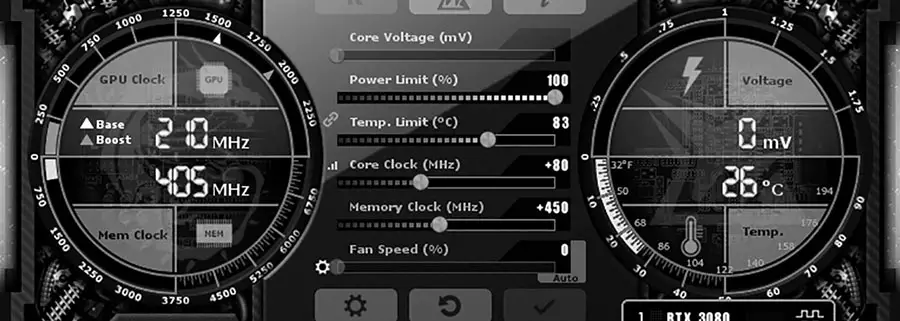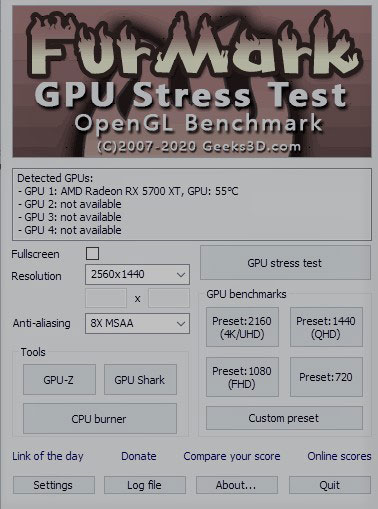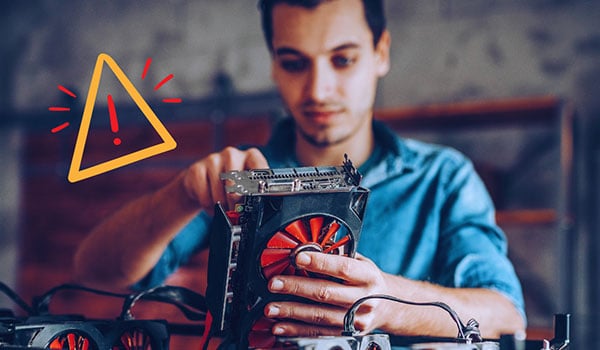Overclocking a GPU means increasing clock speeds beyond the manufacturer’s rated specifications to achieve better performance. If done properly, it can result in enhanced gaming and application performance. Overclocked components produce more heat. If your cooling solution isn’t sufficient, the GPU can overheat, leading to potential long-term damage or reduced lifespan.
An overclocked GPU might become unstable, causing system crashes, graphical artifacts, or application errors. Overclocking a GPU can increase frames per second (FPS) in video games and other graphical workloads. If the CPU, RAM, or any other component is the primary bottleneck in a system, then overclocking the GPU will not yield significant improvements in FPS.
Does overclocking reduce GPU lifespan?
If someone isn’t familiar with the overclocking process and the software tools involved, there’s a potential to set incorrect values, leading to immediate instability or even hardware damage.
Overclocking a GPU involves running it at a higher frequency than it was designed for, leading to increased temperatures, increased power consumption, and greater stress on the hardware. As such, there is potential for overclocking to reduce the lifespan of a GPU. Here’s why:
Increased Temperatures: One of the most significant effects of overclocking is an increase in operating temperatures. Higher temperatures can lead to accelerated wear and tear on the electronic components of the GPU. Over time, this can lead to a reduced lifespan.
Voltage Increases: To achieve stable overclocks, enthusiasts increase the voltage supplied to the GPU. Increased voltage can exacerbate heat production and cause electromigration, a phenomenon where metal atoms in circuits move, leading to circuit degradation or failure over time.
Component Stress: Continuously pushing the GPU to its limits increases the stress on its components. While modern GPUs are robust and can handle a fair amount of stress, constantly running at the edge can introduce wear and the potential for early failure.
Reduced Fail-Safe Threshold: GPUs have built-in thermal and power protection mechanisms. Overclocking can push the GPU closer to these limits, reducing the margin of safety and increasing the risk of hitting these thresholds.
Things you can do to fix it:
Cooling Matters: If you invest in adequate cooling solutions that keep the GPU temperatures in check even when overclocked, the negative impact on lifespan can be somewhat mitigated. This is why many overclocking enthusiasts invest in high-quality cooling solutions.
Manufacturers’ Perspective: Some GPUs are designed with overclocking in mind and have built-in safeguards to prevent damage. However, regularly running a GPU outside its specifications may void its warranty.
Silicon Degradation is Gradual: An overclocked GPU will suddenly fail after a short period. Degradation is a gradual process. Depending on the degree of overclocking and other conditions (like cooling), an overclocked GPU might still last for years without noticeable issues.
In summary, while overclocking can reduce the lifespan of a GPU, the actual impact varies based on the extent of the overclock, the cooling solution, the quality of the GPU, and other factors. If you decide to overclock, monitor temperatures, use reliable tools to test stability, and be prepared for the potential risks.
How much does overclocking shorten lifespan?
Quantifying exactly how much overclocking shortens the lifespan of a GPU (or any component) is challenging due to the wide range of variables involved. Factors such as the specific hardware, the amount of voltage increase, the cooling quality, ambient temperature, and the workload can all influence the outcome.

However, while we don’t have precise figures, here’s a general overview:
Minor Overclocks: Mild overclocking, where the GPU is pushed just slightly beyond its stock settings, usually has a negligible impact on lifespan, especially if the GPU is well-cooled and not overvolted.
Moderate to High Overclocks: When the GPU is pushed further, with significant increases in clock speed and voltage, the reduction in lifespan becomes more noticeable. However, “noticeable” is relative. If a GPU is expected to last 10 years under normal use (and this is a conservative estimate for many modern GPUs), it can last 8 or 9 years under moderate to high overclocks.
Extreme Overclocking: In situations where the GPU is pushed to its absolute limits like in competitive overclocking scenarios where extreme cooling solutions like liquid nitrogen are used, the lifespan can be significantly shortened. But these situations do not represent typical user experiences and involve pushing hardware beyond normal operational limits.
How to check GPU health?
Checking the health of your GPU is essential to ensure optimal performance and longevity. There’s no singular tool or method that provides a comprehensive “health check,” but several methods can give you a general idea of your GPU’s health:

Visual Inspection:
Before using any software tools, physically inspect the GPU. Ensure it’s free of dust and debris, all fans work, and no capacitors are bulging or leaking.
Check GPU Temperatures:
A consistently overheating GPU can indicate wear, damage, or inefficient cooling. Tools like MSI Afterburner, HWMonitor, or proprietary utilities from NVIDIA and AMD can help monitor GPU temperatures.
Stress Testing:
Tools such as FurMark or Unigine’s Heaven & Valley can stress the GPU, pushing it to its limits. There might be an issue if the GPU crashes, shows artifacts, or overheats rapidly during these tests.
Check for Artifacts:
Artifacts are graphical glitches that can appear as strange lines, colors, or patterns. They can be an indication of a failing GPU or VRAM. Use tools like OCCT to run tests that can identify artifacts.
Benchmarking:
Tools like 3DMark can benchmark your GPU and compare its performance to similar systems.
Check VRAM:
VRAM (Video RAM) issues can sometimes be mistaken for GPU problems. Tools like Video Memory Stress Tests can help you check the health of the VRAM.
Drivers and Software:
Ensure you’re using the latest drivers for your GPU. Outdated or corrupt drivers can cause issues that might appear as GPU health problems.
If you experience issues, try uninstalling the GPU drivers using a Display Driver Uninstaller (DDU) tool and reinstalling the latest drivers.
Event Logs:
Check the Event Viewer on Windows for any critical errors or warnings related to the GPU. On Linux, you can examine logs using tools like dmesg or the /var/log/Xorg.0.log file.
Manufacturer Utilities:
Some GPU manufacturers offer diagnostic tools that can check for hardware issues. Refer to your GPU manufacturer’s website or software suite.
Regular maintenance, like cleaning out dust and ensuring good airflow, can contribute to the health and lifespan of your GPU.
How to check GPU temperature?
Monitoring your GPU’s temperature is equally crucial, especially for those who game, use graphical software, or perform GPU-intensive tasks. Depending on your operating system and preference, various methods, and tools can help you monitor GPU temperatures:

Windows:
a. MSI Afterburner:
- A popular tool not just for overclocking but also for monitoring GPU temperatures.
- Download MSI Afterburner.
- Once installed, launch it, and the main window will display your GPU’s temperature.
b. NVIDIA Control Panel:
- If you have an NVIDIA GPU, right-click on the desktop and select NVIDIA Control Panel.
- Navigate to “Help” and select “System Information.” The temperature can be found under the ‘Thermal Data’ section.
c. AMD Radeon Settings:
- If you have an AMD GPU, right-click on the desktop and select AMD Radeon Settings.
- Navigate to the “System” tab and the “Hardware” section. The temperature should be displayed here.
d. HWMonitor:
- As mentioned before, HWMonitor also monitors GPU temperatures.
macOS:
iStat Menus: This application also covers GPU temperatures among its system metrics.
- Download and install iStat Menus.
- After launching, it provides a detailed view of GPU temperature.
Linux:
a. NVIDIA GPUs:
- If you’re using the proprietary NVIDIA driver, you can use the
nvidia-smicommand in the terminal:nvidia-smiThis will provide various details, including GPU temperature.
b. AMD GPUs:
- For AMD GPUs, you can often find temperature information in the sysfs filesystem:
cat /sys/class/drm/card0/device/hwmon/hwmon0/temp1_input. This will give the temperature in milliCelsius, so you might get a value like60000, representing60.0°C.
c. psensor:
- As mentioned earlier, the
psensorGUI tool can provide temperature readings for GPUs as well.
Check the manufacturer’s recommended and maximum temperature limits for your specific GPU model. Ensure your system’s cooling is efficient to avoid damage or performance degradation.
Guide before overclocking GPU
Here is a general overview of the steps and considerations one should keep in mind:
Backup Important Data: Before you start, ensure all your important data is backed up. While the risk of data loss from GPU overclocking is minimal, safeguarding your data’s always a good practice.
Research: Read about your specific GPU model. Some GPUs may have known overclocking limits or quirks. Forums and user communities, such as those on Reddit or specialized websites like Overclock.net, can be valuable resources.
Benchmark Baseline Performance: Before starting the overclocking process, run benchmarks on your GPU to understand its current performance. This gives you a baseline to compare with after overclocking.
Update Drivers: Ensure you have the latest drivers for your GPU. Manufacturers release updates that can improve stability and performance.
Choose an Overclocking Utility: Tools like MSI Afterburner, EVGA Precision X, and ASUS GPU Tweak II are popular choices for GPU overclocking. These tools allow you to adjust clock speeds and voltage and monitor GPU temperatures.
Adjust Clock Speeds Incrementally: Start by increasing the core clock speed in small increments, say 10-20 MHz at a time. After each adjustment, test the GPU’s stability using benchmarking tools.
Monitor Temperatures: Keep a close eye on GPU temperatures. It can become unstable or even damaged if the GPU gets too hot. Most modern GPUs should stay below 85°C, though keeping temperatures lower is preferable.
Test Memory Clock Speeds: Once you’ve found a stable core clock speed, you can incrementally increase the memory clock speed. Follow a similar process: increase slowly and test for stability.
Adjust Voltage (with Caution): Increasing the voltage can help stabilize higher clock speeds. However, it also increases heat output and can potentially reduce the lifespan of the GPU. Only adjust voltage if you’re confident and have adequate cooling.
Stress Test: Once you’ve found your desired overclock settings, run extended stress tests to ensure long-term stability. Tools like FurMark, 3DMark, or Unigine Heaven/Valley can be used for this purpose.
Fine-tune and Monitor: Overclocking can sometimes lead to unexpected issues that only emerge after extended use. Monitor for any graphical glitches, unexpected crashes, or other anomalies when using your PC normally.
Understand the Risks: Overclocking is generally safe, but there’s always some risk. Increased heat and voltage can reduce component lifespan.
Final Words
While overclocking can reduce the theoretical lifespan of a component, many users will never see this impact in practical terms. Many users replace their GPUs every few years to stay current with technological advances. So even if overclocking reduces the GPU’s lifespan from 10 to 8 years, it’s not a practical concern for someone who upgrades every 3-4 years.
Not every GPU will react to overclocking in the same way. Silicon manufacturing processes have inherent variability, leading to the “silicon lottery,” where some chips can overclock more effectively and with less impact than others. If you’re considering overclocking, always ensure you have a proper cooling solution, regularly monitor temperatures, and be aware of the potential risks.
Learn More:
Table of Contents
